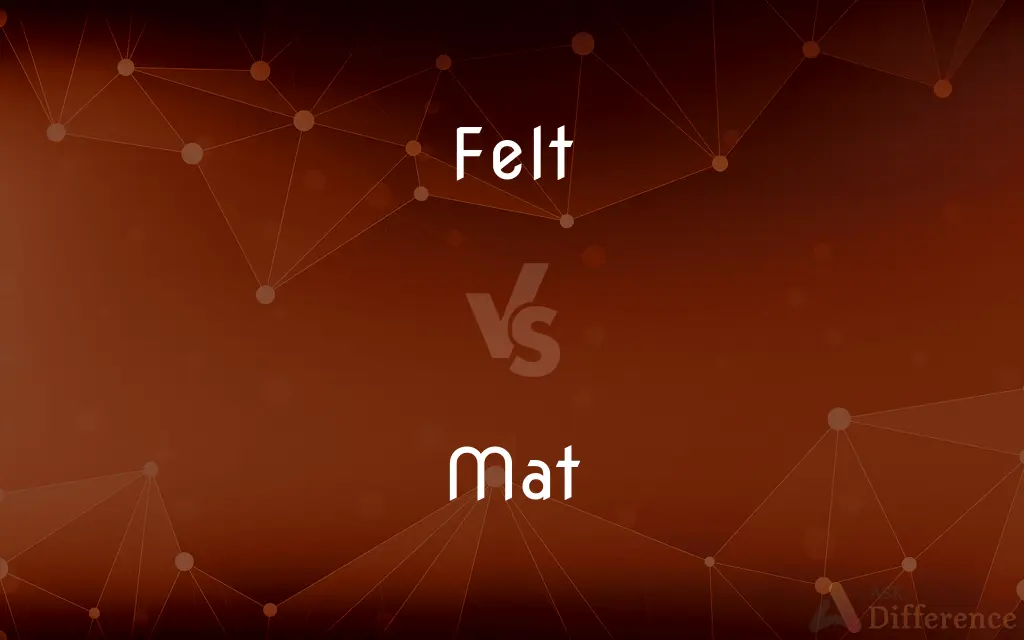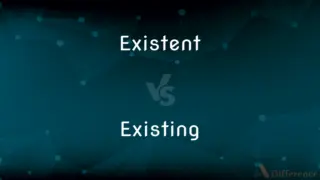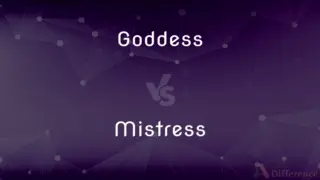Felt vs. Mat — What's the Difference?
By Tayyaba Rehman & Urooj Arif — Updated on March 29, 2024
Felt is a non-woven fabric made from compressed fibers, while a mat is a piece of material placed on a floor or other surface for various purposes.

Difference Between Felt and Mat
Table of Contents
ADVERTISEMENT
Key Differences
Felt is created through a process that mats fibers together, using heat, moisture, and pressure, resulting in a dense fabric. This material can be made from wool, synthetic fibers, or a blend of both, and is known for its durability, insulation properties, and resistance to tearing. It's used in a wide range of applications, from craft projects and clothing to industrial uses like insulation and soundproofing. A mat, on the other hand, is a general term for a piece of fabric or other material used to cover a surface. Mats can serve various functions such as protecting floors, providing a clean or cushioned surface, or decorating a space. They come in many forms, including doormats, bath mats, and yoga mats, each designed with a specific purpose in mind. The material of a mat can vary widely, including rubber, textiles, plastic, and more.
While felt can be used to make certain types of mats, the term "mat" encompasses a much broader range of materials and purposes. Felt mats might be used for decorative purposes, as placemats, or for craft projects, benefiting from felt's texture and fabric properties.
In terms of manufacture, felt is unique for being a non-woven fabric, whereas mats can be made from a variety of manufacturing processes, including weaving, knitting, or simply cutting to size from larger sheets of material.
Understanding the distinction between felt and mats is crucial for selecting the right material for specific needs, whether for craft, industrial, home use, or otherwise. Felt's unique properties make it suited for applications requiring durability and resistance, while mats' variety offers solutions for comfort, cleanliness, and protection across different settings.
Comparison Chart
Material
Compressed fibers (wool, synthetic)
Various (textile, rubber, plastic)
ADVERTISEMENT
Manufacture
Non-woven, made through compression
Woven, knitted, or cut to shape
Usage
Crafts, insulation, clothing
Floor protection, cleanliness, decor
Properties
Durable, insulating, tear-resistant
Varies widely, often for specific uses
Examples
Craft felt, industrial felt
Doormats, yoga mats, bath mats
Compare with Definitions
Felt
Tear-resistant fabric.
The felt fabric was chosen for its ability to withstand wear and tear.
Mat
Can be made from textiles, rubber, or plastic.
Rubber mats are used in industrial settings for safety.
Felt
A non-woven fabric made from compressed fibers.
She used colorful felt to create handmade dolls.
Mat
Used for protection, cleanliness, or decoration.
The decorative mat added a cozy feel to the room.
Felt
Durable and insulating material.
Felt is used for insulation in construction projects.
Mat
A piece of material placed on a surface.
He wiped his shoes on the doormat before entering.
Felt
Made from wool, synthetic, or blended fibers.
Wool felt is preferred for its natural properties.
Mat
Comes in various forms like doormats and yoga mats.
She rolled out her yoga mat for the morning session.
Felt
Versatile for crafts and industrial uses.
Industrial machines often use felt for sealing components.
Mat
Designed with specific purposes in mind.
Bath mats are designed to absorb water and prevent slipping.
Felt
Felt is a textile material that is produced by matting, condensing and pressing fibers together. Felt can be made of natural fibers such as wool or animal fur, or from synthetic fibers such as petroleum-based acrylic or acrylonitrile or wood pulp-based rayon.
Mat
A mat is a piece of fabric material that generally is placed on a floor or other flat surface.
Felt
A fabric of matted, compressed animal fibers, such as wool or fur, sometimes mixed with vegetable or synthetic fibers.
Mat
A flat piece of coarse fabric or other material used for wiping one's shoes or feet, or in various other forms as a floor covering.
Felt
A material resembling this fabric.
Mat
A small flat piece of decorated material placed under a lamp, dish of food, or other object.
Felt
Something made of this fabric.
Mat
(Sports) A floor pad to protect athletes, as in wrestling or gymnastics.
Felt
Made of, relating to, or resembling felt.
Mat
A densely woven or thickly tangled mass
A mat of hair.
Felt
To make into felt.
Mat
The solid part of a lace design.
Felt
To cover with felt.
Mat
A heavy woven net of rope or wire cable placed over a blasting site to keep debris from scattering.
Felt
To press or mat (something) together.
Mat
A decorative border placed around a picture to serve as a frame or provide contrast between the picture and the frame.
Felt
To become like felt; mat together.
Mat
A dull, often rough finish, as of paint, glass, metal, or paper.
Felt
Past tense and past participle of feel.
Mat
A special tool for producing such a surface or finish.
Felt
A cloth or stuff made of matted fibres of wool, or wool and fur, fulled or wrought into a compact substance by rolling and pressure, with lees or size, without spinning or weaving.
Mat
(Printing) See matrix.
Felt
A hat made of felt.
Mat
To cover, protect, or decorate with mats or a mat.
Felt
A felt-tip pen.
Mat
To pack or interweave into a thick mass
High winds matted the leaves against the base of the fence.
Felt
(obsolete) A skin or hide; a fell; a pelt.
Mat
To be packed or interwoven into a thick mass; become entangled.
Felt
(transitive) To make into felt, or a feltlike substance; to cause to adhere and mat together.
Mat
To put a mat around (a picture).
Felt
(transitive) To cover with, or as if with, felt.
To felt the cylinder of a steam engine
Mat
To produce a dull finish on.
Felt
To cause a player to lose all their chips.
Mat
Variant of matte1.
Felt
Simple past tense and past participle of feel
Mat
A flat piece of coarse material used for wiping one’s feet, or as a decorative or protective floor covering.
Wipe your feet on the mat before coming in.
Felt
That has been experienced or perceived.
Mat
A small flat piece of material used to protect a surface from anything hot or rough; a coaster.
They put mats on the table during mealtimes.
Felt
A cloth or stuff made of matted fibers of wool, or wool and fur, fulled or wrought into a compact substance by rolling and pressure, with lees or size, without spinning or weaving.
It were a delicate stratagem to shoeA troop of horse with felt.
Mat
(athletics) A floor pad to protect athletes.
The high jumper cleared the bar and landed safely on the mat.
Felt
A hat made of felt.
Mat
A thickly tangled mess.
A mat of weeds
Felt
A skin or hide; a fell; a pelt.the grain of timber which is transverse to the annular rings or plates; the direction of the medullary rays in oak and some other timber.
To know whether sheep are sound or not, see that the felt be loose.
Mat
A thin layer of woven, non-woven, or knitted fiber that serves as reinforcement to a material.
Felt
A fabric made of compressed matted animal fibers
Mat
A thin surface layer; superficial cover.
Iceland moss growing in a mat
Felt
Mat together and make felt-like;
Felt the wool
Mat
(coppersmithing) An alloy of copper, tin, iron, etc.; white metal.
Felt
Cover with felt;
Felt a cap
Mat
Abbreviation of matinee
Felt
Change texture so as to become matted and felt-like;
The fabric felted up after several washes
Mat
A material or component needed for a crafting recipe.
To make a luck potion, you need several rare herbs as mats.
Mat
(transitive) To cover, protect or decorate with mats.
Mat
(intransitive) To form a thick, tangled mess; to interweave into, or like, a mat; to entangle.
Mat
A name given by coppersmiths to an alloy of copper, tin, iron, etc., usually called white metal.
Mat
A thick flat fabric of sedge, rushes, flags, husks, straw, hemp, or similar material, placed on the floor and used for wiping and cleaning shoes at the door, for covering the floor of a hall or room to protect its surface, and for other purposes.
Mat
Any similar flat object made of fabric or other material, such as rubber or plastic, placed flat on a surface for various uses, as for covering plant houses, putting beneath dishes or lamps on a table, securing rigging from friction, and the like.
Mat
Anything growing thickly, or closely interwoven, so as to resemble a mat in form or texture; as, a mat of weeds; a mat of hair.
Mat
An ornamental border made of paper, pasterboard, metal, etc., put under the glass which covers a framed picture; as, the mat of a daguerreotype.
Mat
Cast down; dejected; overthrown; slain.
When he saw them so piteous and so maat.
Mat
To cover or lay with mats.
Mat
To twist, twine, or felt together; to interweave into, or like, a mat; to entangle.
And o'er his eyebrows hung his matted hair.
Mat
To grow thick together; to become interwoven or felted together like a mat, as hair when wetted with a sticky substance; as, a long-haired cat whose fur is matted.
Mat
A thick flat pad used as a floor covering
Mat
Mounting consisting of a border or background for a picture
Mat
Sports equipment consisting of a piece of thick padding on the floor for gymnastic sports
Mat
A master's degree in teaching
Mat
The property of having little or no contrast; lacking highlights or gloss
Mat
A small pad of material that is used to protect surface from an object placed on it
Mat
Twist together or entwine into a confusing mass;
The child entangled the cord
Mat
Change texture so as to become matted and felt-like;
The fabric felted up after several washes
Mat
Not reflecting light; not glossy;
Flat wall paint
A photograph with a matte finish
Common Curiosities
Can felt be used to make mats?
Yes, felt can be used to make certain types of mats, especially for decorative purposes or crafts.
What kinds of mats are there?
Mats include doormats, bath mats, yoga mats, and more, each designed for specific uses like cleanliness, safety, or comfort.
What are the unique properties of felt?
Felt is known for its durability, insulation properties, and resistance to tearing, making it suitable for a wide range of applications.
Are all mats made from the same material?
No, mats can be made from a variety of materials, including textiles, rubber, plastic, and even felt, depending on their intended use.
What is the primary difference between felt and a mat?
Felt is a non-woven fabric made from compressed fibers, while a mat is a broader term for any piece of material used to cover a surface for various purposes.
How is felt manufactured?
Felt is manufactured by matting fibers together through a process involving heat, moisture, and pressure, without weaving or knitting.
What are some common uses of felt?
Felt is used in crafts, clothing, industrial insulation, and soundproofing, among other applications.
How do I choose between felt and a mat for a project?
The choice depends on the project's needs: felt is suitable for applications requiring durable, insulating material, while mats are chosen based on the specific function, such as floor protection or decoration.
Can mats be recycled?
Some mats, especially those made from recyclable plastics or natural materials, can be recycled, depending on local recycling facilities.
Can a yoga mat be made of felt?
While unusual, a yoga mat could be made from felt for its cushioning properties, but traditional yoga mats are usually made from materials with better grip and moisture resistance.
What is the environmental impact of felt and mats?
The impact varies by material: natural wool felt is biodegradable, while synthetic felt and some mat materials like plastic may have a higher environmental footprint.
How are mats for outdoor use designed?
Outdoor mats, such as doormats, are designed with durability and weather resistance in mind, often made from materials like rubber or weather-resistant textiles.
Is felt a good choice for clothing?
Felt can be used in clothing, especially for items requiring warmth and durability, though its breathability and comfort vary based on the fiber composition.
What distinguishes industrial felt from craft felt?
Industrial felt is denser, thicker, and made for specific technical applications, while craft felt is lighter, available in various colors, and used for artistic projects.
How does the manufacturing process of mats vary?
The process can vary widely, from weaving and knitting for textile mats to molding and cutting for rubber and plastic mats, depending on the material and intended use.
Share Your Discovery

Previous Comparison
Existent vs. Existing
Next Comparison
Goddess vs. MistressAuthor Spotlight
Written by
Tayyaba RehmanTayyaba Rehman is a distinguished writer, currently serving as a primary contributor to askdifference.com. As a researcher in semantics and etymology, Tayyaba's passion for the complexity of languages and their distinctions has found a perfect home on the platform. Tayyaba delves into the intricacies of language, distinguishing between commonly confused words and phrases, thereby providing clarity for readers worldwide.
Co-written by
Urooj ArifUrooj is a skilled content writer at Ask Difference, known for her exceptional ability to simplify complex topics into engaging and informative content. With a passion for research and a flair for clear, concise writing, she consistently delivers articles that resonate with our diverse audience.
















































